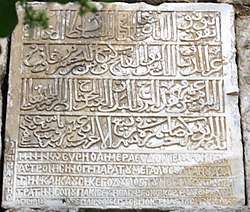Kaykaus I
Kaykaus I or Kayka'us I or Keykavus I (Old Anatolian Turkish: كَیکاوس, Persian: عز الدين كيكاوس بن كيخسرو ʿIzz ad-Dīn Kaykāwūs ibn Kaykhusraw) was the Sultan of Rum from 1211 until his death in 1220. He was the eldest son of Kaykhusraw I.
| Kaykaus I | |||||
|---|---|---|---|---|---|
| Seljuq sultans of Rum | |||||
| Reign | 1211–1220 | ||||
| Predecessor | Kaykhusraw I | ||||
| Successor | Kayqubad I | ||||
| Died | 1220 | ||||
| |||||
| Father | Kaykhusraw I | ||||
Succession
Upon the death of Kaykhusraw I at the Battle of Alaşehir in 1211,[1] Kaykaus’ two younger brothers, Kayferidun Ibrahim and the future Kayqubad I, challenged his succession. Kayqubad initially garnered some support among the neighbors of the sultanate, Leo I, the king of Cilician Armenia, and Tughrilshah, his uncle and the independent ruler of Erzurum. At the same time, Kayferidun imperiled the recently acquired port of Antalya by seeking aid from the Cypriot Franks. Most of the emirs, as the powerful landed aristocracy of the sultanate, supported Kaykaus. From his base in Malatya, Kaykaus seized Kayseri and then Konya, inducing Leo to change sides. Kayqubad was forced to flee to the fortress at Ankara, where he sought aid from the Turkman tribes of Kastamonu. Kaykaus soon apprehended both of his brothers and secured the throne for himself.[2]
During this time of considerable danger, Kaykaus negotiated a peace settlement with Theodore Laskaris, the Byzantine Emperor of Nicaea. This treaty marked the end of hostilities between the Seljuq state and the Empire of Nicaea, though Turkmen nomads continued occasionally to trouble the border.[3]
The Eastern Frontier and Fifth Crusade
With Antalya secure and the western marches at peace, Kaykaus turned his attentions to the east. During the Fifth Crusade, the crusaders allied with Kaykaus and forced the Ayyubids to undertake a two-front conflict.
Conquest of Sinope

Kaykaus’ most significant contribution to the Seljuq state was the acquisition the Black Sea port of Sinop. In 1214 turkic tribesmen captured Alexios, Grand Komnenos of the Empire of Trebizond, on a hunting trip outside of the city. The hostage was turned over to the sultan and negotiated his freedom in exchange for Sinope and the vassalage of Trapezuntine territory to the east. The Seljuqs gained an outlet on the Black Sea to match their Mediterranean port at Attalea, and a wedge was driven between the Empire of Trebizond and the Byzantine Empire of Nicaea. The transfer was affected on Sunday 1 November with both the sultan and the Grand Komnenos present. Alexios was entertained for several days and then politely asked to return to Trebizond.[4]
After the transfer, European and Byzantine trade continued in the city. Kaykaus named an Armenian, Rais Hetoum, to govern the mixed Greek and Turkish population.[5] Churches in the city of Sinope were converted to mosques, on Kaykaus's command.[6] Between April and September 1215 the walls were reconstructed under the supervision of the Greek architect, Sebastos. Fifteen Seljuq emirs contributed to the cost. The work is commemorated by a bilingual Greek and Arabic inscription on a tower near the western gate.[4]
Identity
According to Rustam Shukurov, it is very probably that Kaykaus I and his brother Kayqubad I, who both spent considerable time in Constantinople with their father, had the same dual confessional (Christian and Muslim) and dual ethnic (Turkic/Persian and Greek) identity as Kaykhusraw I, Kaykaus II, and Masud II.[7]
Monuments
In 1212 Kaykaus built a madrasa in Ankara[6] and in 1217 the Şifaiye Medresesi in Sivas. The latter was designed as a hospital and medical school. The sultan’s mausoleum is in the south eyvan of the building under a conical dome. The façade includes a poem by the sultan in blue faience tiles.[1]
References
- Redford 1991, p. 54-74.
- Cahen 1968, p. 120-121.
- Cahen 1968, p. 121.
- Bryer & Winfield 1985, p. 71-72.
- Cahen 1968, p. 123.
- Crane 1993, p. 6.
- Peacock & Yildiz 2013, p. 133.
Sources
- Bryer, Anthony; Winfield, David (1985). The Byzantine Monuments and Topography of the Pontos. vol. 1. Dumbarton Oaks.CS1 maint: ref=harv (link)
- Cahen, Claude (1968). Pre-Ottoman Turkey: A general survey of the material and spiritual culture and history c. 1071-1330. New York: Taplinger. pp. 120–121. hdl:2027/heb.00871. ISBN 1-59740-456-X.CS1 maint: ref=harv (link)
- Crane, H. (1993). "Notes on Saldjūq Architectural Patronage in Thirteenth Century Anatolia". Journal of the Economic and Social History of the Orient. 36 (1): 1–57. doi:10.1163/156852093X00010.CS1 maint: ref=harv (link)
- Peacock, A.C.S.; Yildiz, Sara Nur, eds. (2013). The Seljuks of Anatolia: Court and Society in the Medieval Middle East. I.B.Tauris. ISBN 978-0857733467.CS1 maint: ref=harv (link)
- Redford, Scott (1991). "The Alaeddin Mosque in Konya Reconsidered". Artibus Asiae. Zürich: Artibus Asiae Publishers. 51 (1/2): 54–74 [70]. doi:10.2307/3249676. ISSN 0004-3648. JSTOR 3249676.CS1 maint: ref=harv (link)
| Preceded by Kaykhusraw I |
Sultan of Rûm 1211–1220 |
Succeeded by Kayqubad I |